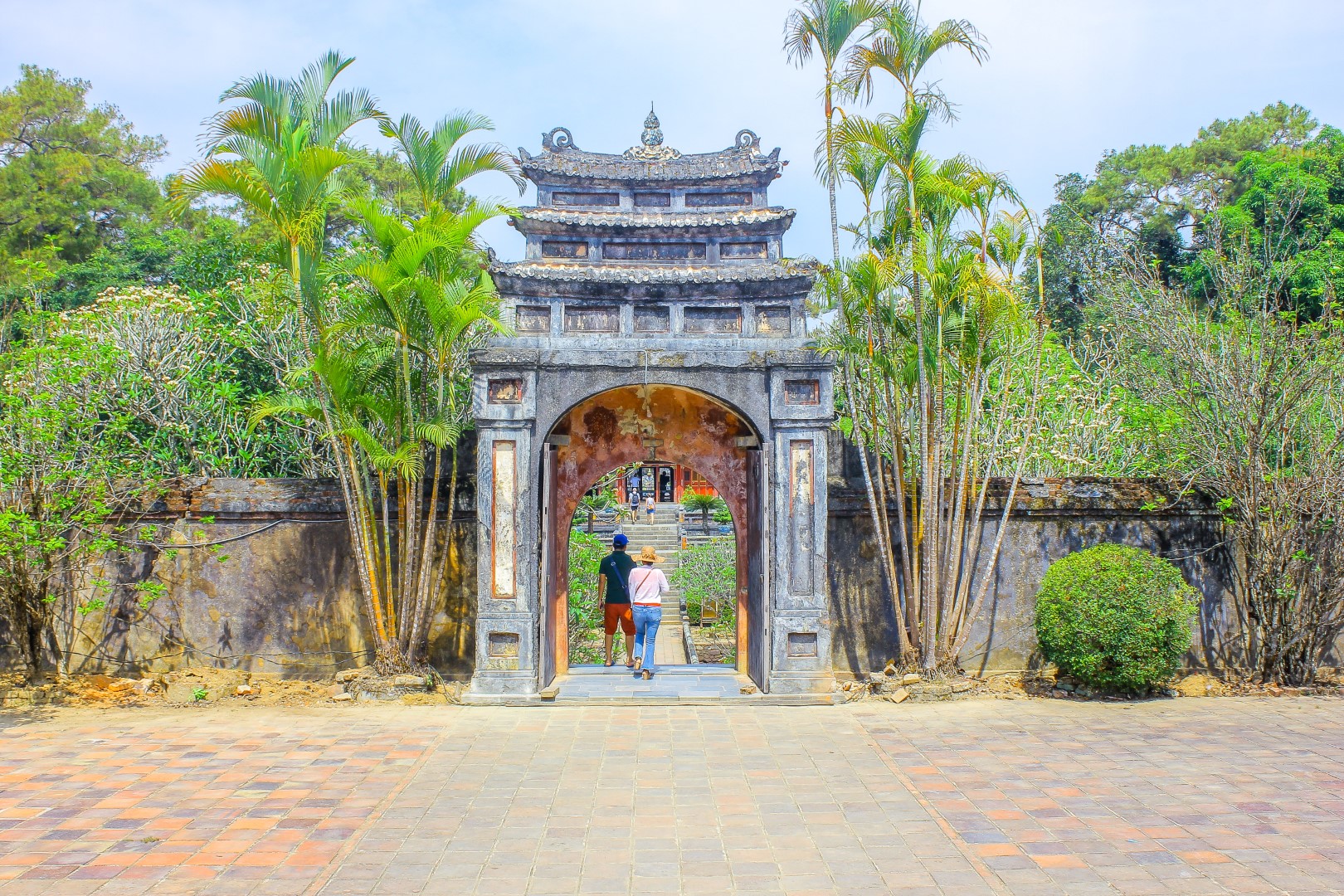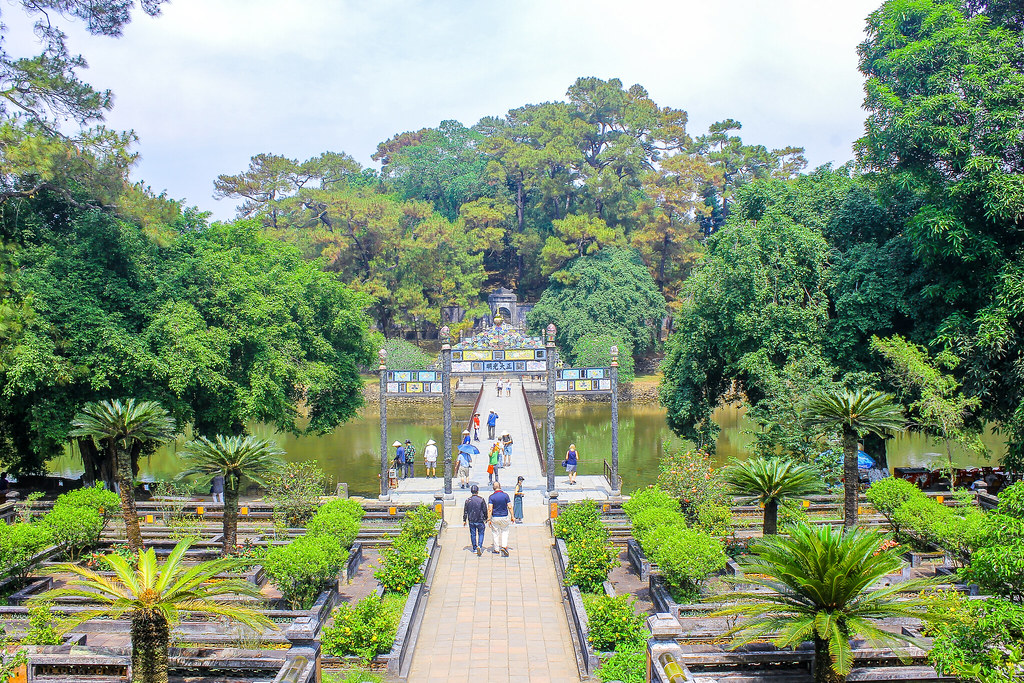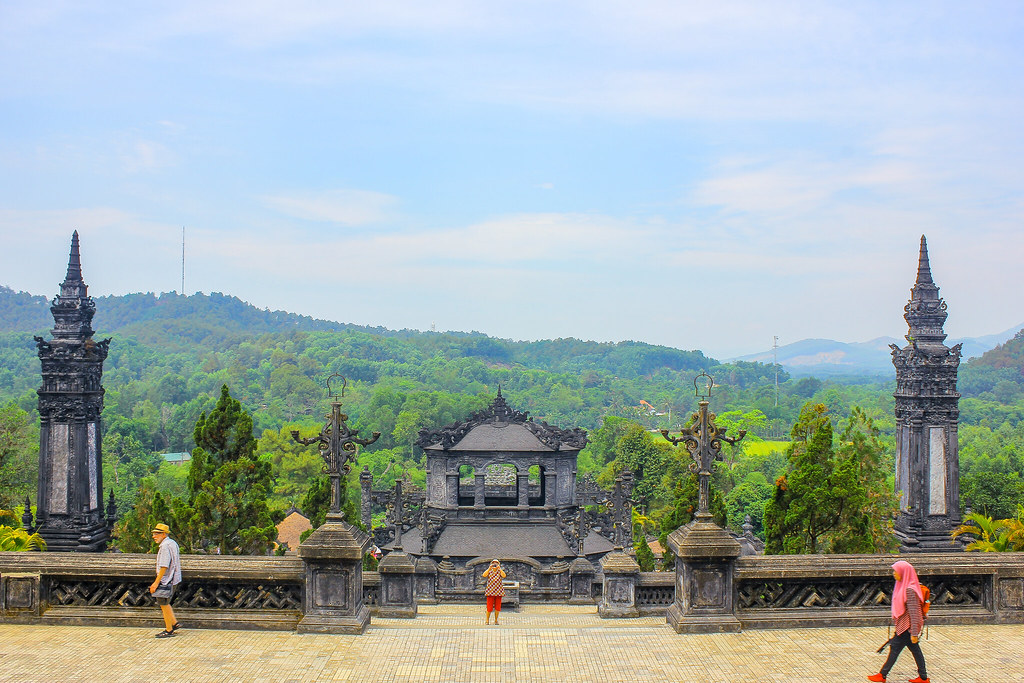
Tombs of the Vietnamese emperors today. Breakfast at the Saigon Morin, under the leafy trees in the courtyard. Calm, tranquil start to the day. A refuge from the heat, noise and dust that awaits us outside our five-star fortress. Pedestal fans waft the humid air amongst the guests, as we are served tea, coffee and fresh juice. More fresh pastries, and eggs made to order. It’s almost embarrassingly classy.
Picked up for our tour at the leisurely time of 9am and straight out to see the tombs of the kings dotted around Hue. Traffic this morning is intense, snarled and slow through the streets. Our driver apologises profusely. Holiday spots like Hue are busy and crowded as locals make the most of the long weekend approaching. You can feel a party brewing.
Hue isn’t all gleaming glass and high rises. Most buildings are old, the familiar higgledy-piggledy rectangular boxes we saw in the older parts of Ho Chi Minh City. Shophouses turned into restaurants, guesthouses, shops and mechanics. There’s a lot more temples and shrines around here. The city dies to a smattering of buildings and small villages, before finally giving way to lush jungle. It’s gloriously green and shady, despite the unbelievable heat. We wind along the bank of the lazy Perfume River – a deep, dark swathe cutting through the green hills around us. A boat floats along slowly; so slowly, it almost doesn’t make any ripples. Life moves slower here.

The tomb of emperor Minh Mang is first on our list. It’s not just a tomb, as such. It’s an entire complex, set amongst rolling gardens and a lake. Visitors walk a long paved promenade, through temples, prayer halls and across bridges along the way. The buildings are decorated lavishly, with reds, yellows and greens, statues and wooden carvings. I inspect each tile and details closely. Courtyards open to perfectly manicured bonsais in glazed pots, burly lions stand guard at the foot of staircases. The courtyards are largely unshaded and the terracotta tiles are frying-pan hot. There’s a theatre, and a hall for official greetings. Each stop seems grander than the last, until we reach the end. We descend from the final steps, to a bridge across a crescent moon shaped lake. At the top of a set of another set of stairs, there’s an imposing round door. Beyond this, lies Minh Mang. The door is opened very rarely, and I can only imagine the scene beyond.
We make tracks to the next tomb, belonging to Khai Dinh. The emperor ordered his palatial and extravagant tomb to be built on the side of a mountain, and taxed his subjects heavily (which obviously didn’t make him very popular). I was similarly cursing his name, hauling myself up the 127 steps under the already blazing sun. While the surrounding mountainside was green and lush, the tomb gate was and steps were grey and terrifying. Everything looks dark and brooding, and its not until we reach the actual tomb itself at the top does the beauty of the place become apparent. The view is spectacular, across to the neighbouring mountain and down the valley. Inside, the walls are adorned with immense porcelain and glass mosaics. Floor to ceiling. The ceilings feature elaborately painted dragons, woven into swirling clouds. The contrast of the harsh concrete exterior with the lavish interior is amazing. I catch myself thinking this is some ancient king from the 8th century, when in reality Khai Dinh ruled until his death in 1925. The walk back down to street level is a leg shaking 127 steps.

Nothing prepares us for the immense size of the next tomb. Emperor Tu Duc designed such an elaborate tomb, that he and his 100+ wives and concubines, lived there in palaces specially built. Like a summer house. We trace the edge of the lake, walking under the sun. The tiles are terracotta and if I stand still for too long, I think I can smell my shoes starting to melt. Within Tu Duc’s tomb complex, there’s not only palaces and sleeping quarters for his wives and women, there’s theatres museums and throne halls. Wide rectangular buildings of teak wood and stone floors, facing each other to create inner courtyards. Potted bonsai plants are usually the only decorations in these courtyards. We’ve done the tombs in reverse order, to avoid a majority of the bus tour groups – which has worked a treat. Even though we’re here in the low season, Hue is the land of the bus package tour. They travel in great swarms throughout the day, and we sit and watch their return at sundown. Walking through Tu Duc’s tomb complex on our own feels like we’re walking through an abandoned city. Some sections are well looked after, freshly renovated and perfectly manicured. Other sections are crumbling stone, black with soot and covered in dust. We are permitted to walk much further and more freely than the last two tombs. So much so, that at one point I think we are lost, when in reality, we were standing in front of Tu Duc’s actual tomb. Rumour has it he was buried in secret elsewhere in Hue, and the servants who buried him were beheaded after the finished the job. Gnarly. We depart from the footpath, and follow a worn path in the grass which weaves through the garden. There’s another dilapidated building to our left. It’s the tomb of Tu Duc’s primary wife, under renovation and out of bounds today. We pass neatly manicured garden beds, filled with flowering plants, and pop back through the complex wall to the main road. Our driver waves us over, hands us cold water and says with a grin, “lunch?”.

‘Don’t eat veggies or fruit you can’t peel’ is pretty much the golden rule of eating overseas, if you want to avoid the dreaded “Dehli Belly”. We roll up to a restaurant, our driver waving to the waiters inside. The place is packed, which is some comfort but when the first dish lands I notice there is fresh lettuce. Oh god. Red flag. Our driver tucks straight in. Husbando and I share a look – this will either be delightful, or we’ll spend the night in the bathroom. Our driver pipes up, as if he’s read our minds – “they wash the lettuce in clean water, see the big blue bottles?”. Ah yes – the delivered bottles of purified water. The pork is hot and tender, the lettuce is crunchy. The herbs are my favourite. Forget your common household herbs, these are fresher and more complex. There’s herbs in this dish I can’t name but I’m not complaining. I don’t have time to complain if I want to eat another 11 bowls. Its minty, earthy, rich, light, herbaceous and slightly spicy. We also tuck into something called banh uot, which is bit like fresh spring rolls but thicker rice paper wrappers. Ice cold water and fresh hot green tea to complete the meal.
Our last stop for the day is Chùa Thiên Mu, a Buddhist temple perched on a hill on the bank of the Perfume River. I read somewhere that the seven storey pagoda is an unofficial emblem of the city. Another set of daunting stairs to climb, and we are met with the towering pagoda in all its splendour. In a country where higgledy-piggledy buildings are the style, the perfect, seven layer brickwork tower is immensely satisfying to look at. Growing upward, in smaller scaled versions of the layer below, the pagoda remind me of a cake. Complete with tiled roofs and ornamental flourishes, like icing. Except this cake is flanked by leafy green trees, and other Buddhist ornaments housed in smaller stupas. A set of ornate gates which opens to another pathway through the courtyard. At the end, a building made of dark teak wood, where numerous shrines and Buddha images are housed. Locals are praying, kicking their shoes off as they climb the steps to the long house. Buddhist monks still offering blessings here, and pray regularly. Some sections we are forbidden from entering, as they are set aside for the monks. The temple is simple, neat and the centre of a lot of Hue’s history. Here we stand where protests took place, and uprisings started. Its interesting to see what seemingly inconspicuous sites are the centre of the people’s fights. A Buddhist temple, after all, is usually a symbol for peace.

We are properly roasted by the time we climb back down the stairs to the river. We’ve arranged a cruise back to our end of town, along the river. Its a slow, quiet ride aboard another boat made for more than two. A lady sits at the back, rocking a tiny child in a hammock. What sort of a living do they eke out on this boat? I buy a couple of hand painted book marks from her. We lazily make our way down the river, the city of Hue to our right and to the left, the imperial citadel of Hue. A huge Vietnamese flag flies in the smokey breeze, atop the citadel’s fort. I’m ready for a swim and a beer. The boat moves like most of Hue – slow, steady and with the river.
Notes:
- We hired a car and driver for a half day, and our driver hooked us up with the boat ride on the day. Having an air conditioned car to go back to after each tomb was amazing!
- You could do it by scooter, and there is absolutely no shortage of places to hire a set of wheels in Hue. Wear a helmet!
- I recommend the boat ride back down the river after Chùa Thiên Mu. Its a great way to relax and you can put your feet up after a hot day pounding the pavement at the temples and tombs. Some might consider it a little tourist trap, but check your privilege. These are just families trying to earn a living. It won’t kill you to buy a magnet or a bookmark.
- Get the combination ticket for three tombs, and the Hue Imperial City! Its cheaper, and you don’t have to visit the Imperial City the same day – we did it the next day.
Enjoying reading my diary? You can catch up on the rest of my Vietnam Diaries, or read about my Cambodian adventures!